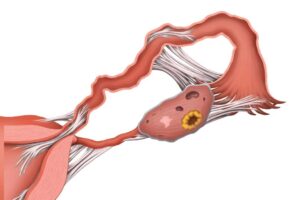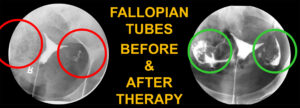Unlock the potential for natural conception with Clear Passage’s groundbreaking, non-surgical therapy that has successfully opened blocked fallopian tubes for 61% of women, offering hope and a 57% pregnancy rate without the risks of surgery.
Contact us today for a Free Consult or to Request Information. To learn more visit our Apply to Therapy page.
“Blocked fallopian tubes” is one of the most heartbreaking diagnoses in female infertility. The female reproductive system consists of many delicate organs tasked with the need to transfer a single cell (the egg) across a gap, then into a tiny canal to unite with another single cell (the sperm). All of this must happen in a relatively narrow window of time each month and must be done by a certain age for fertilization to occur.
Two small organs comprise the main transport tunnel for conception, fallopian tubes. For decades, these tubes have presented significant problems for infertile women and their physicians when they become blocked by internal scars called adhesions.
While reproductive physicians have developed a vast industry to treat female infertility, many medical treatments involve injecting mild to potent hormones or surgery.
Many women ask their doctors, “Are there any complementary or alternative therapies I can try? Is there anything natural or nonsurgical I can do to improve my chance of becoming a mother?”
The answer is a resounding yes!
What are Fallopian Tubes?
Fallopian tubes are tiny, complex, and extraordinary. Found deep within a woman’s pelvis, these two organs are literally the place where life begins. Each fallopian tube is designed to transport fragile single-cell organisms towards each other and help them unite to create a life as they attempt to introduce the mother’s egg to the father’s sperm.
It is unknown why the egg travels down from the ovaries toward the uterus. Some doctors speculate that low pressure in the uterus pulls the egg down with gentle suction, like drinking through a straw. Others believe that the remarkable interior of the tube, an environment that resembles a lush undersea garden with thousands of hair-like cilia, tends to push or coax the egg on its journey toward the uterus. Similarly, scientists do not know what inspires the sperm to swim upstream from the uterus through the tube and toward the ovary to meet and fertilize the egg.
What we do know is that sperm must meet the egg and join inside the fallopian tube for natural fertilization to occur. After that, any disruption for the fertilized egg to continue its journey through the tube for implantation on the uterus wall can cause significant problems for the mother and the fertilized egg.
What causes Fallopian Tubes to become blocked?
Adhesions (Internal Scars)

Blocked Fallopian Tube
Adhesions (Internal Scars)
A common cause of blocked fallopian tubes is the formation of internal scars called adhesions. Frequently found in the female reproductive tract, these tiny glue-like bonds can form anywhere in the body. These inner scars form as the first step in healing from infection, inflammation, surgery, or injury. Once started, adhesions remain in the body for life, sometimes spreading to other structures.
They are often the result of an infection such as pelvic inflammatory disease (PID). When these internal scars bind endometrial tissue to the underlying structures, adhesive bonds are commonly found in patients with endometriosis.
Adhesions can be asymptomatic or can cause significant pelvic or intercourse pain (dyspareunia). Studies conducted by Clear Passage suggest vaginal adhesions cause other sexual dysfunctions such as decreased desire, lubrication, and orgasm. Because adhesions are primarily composed of collagen, a common substance in the body, they are virtually invisible to diagnostic tests such as X-rays, CTs, or MRIs.
Why are my Tubes Blocked?

Fallopian tubes are often blocked by internal scars called adhesions
If you have blocked fallopian tubes or a hydrosalpinx (swollen tube), it is crucial to understand that this is not your fault. The vagina is located at the core of a woman’s body. Its warm, moist environment is designed to promote life– including bacteria. Because items may enter the vagina during a woman’s lifetime, bacteria can enter the body there, causing a clinical or sub-clinical (unrecognized) infection — one that can quickly spread into the uterus and the fallopian tubes. The body’s first response to infection is to lay down adhesions to start the healing process. Once formed, these internal scars can remain in the body for a lifetime.
When these glue-like bonds form within the tube, they can cover the delicate cilia or the walls of the tube, causing ectopic pregnancy, a condition in which the fertilized egg (zygote) becomes trapped in the tube. When adhesions are more extensive, they can block a fallopian tube entirely, preventing any chance for natural conception.
What are Natural Remedies for Blocked Fallopian Tubes
While a plethora of ‘natural’ herbs, vitamins, and potions have been proposed to improve fertility, none of these have been shown in published studies to open blocked fallopian tubes—several purports to increase blood flow or energy to the area. No matter how wonderful a natural adjunct might sound, it is useless to improve blood flow or energy if the tiny but powerful adhesions physically block the tubes.
Only one natural treatment has been cited in peer-reviewed journals for its ability to open blocked fallopian tubes (including hydrosalpinx) and return natural fertility to women.
A hands-on physical therapy called the Clear Passage® Approach (CPA) has been cited in numerous medical journals for opening blocked fallopian tubes with studies that measure the treatment’s effectiveness for various causes of the woman’s infertility.
Scientifically Published Success Rates of the Best Natural Treatment for Infertility
Researchers and therapists at Clear Passage clinics have worked hard to provide accurate success rates for clients considering this therapy. While no legitimate medical technique claims 100% success, CPA results have been consistent and encouraging over the years.
As early as 2002, medical editors at WebMD became intrigued with Clear Passage results. In 2004, data housed at the U.S. National Institutes of Health cited a study from WebMD’s Medscape General Medicine that showed Clear Passage opened blocked fallopian tubes in several women who came to therapy with total blockage. Even more exciting, most participants whose tubes opened had a natural full-term pregnancy, and some had a second (or more) pregnancy and birth with no further therapy. A citation in Fertility and Sterility (2006) cited CPA with clearing hydrosalpinx in 50% of women, again followed by post-therapy natural pregnancies.**
Inspired by results from these pilot studies, researchers conducted a 10-year retrospective study of 1392 infertile women treated with the Clear Passage® Approach. Results were nearly identical to those in the pilot studies, with:
- 61% of women have one or both blocked fallopian tubes cleared by the therapy.
- Success rates were higher (69%) for most women who had never undergone fallopian tube surgery.
- Only 35% of women had tubes open if their tubes were previously cut or burned in a surgery (likely due to post-surgical scarring on the delicate tubes.)
In all the above studies, some participants reported subsequent (2nd and 3rd) pregnancies, indicating that (unlike IVF) the CPA results are long-lasting for some women.
Comparing Clear Passage to Surgery
The 10-year study provided success rates for treating various causes of female infertility. Researchers were surprised to show rates rivaled and sometimes surpassed conventional medical techniques. Published success rates treating women who have been diagnosed infertile with the following conditions note the following:
How Successful has Clear Passage been in Opening Totally Blocked Fallopian Tubes:
- 69% open if no prior tubal surgery
- 35% open on tubes that had prior surgery
- 61% open overall
- 57% confirmed pregnancy rate after tubes were opened
- (vs. 22% – 34% for surgery)
How Successful has Clear Passage been in increasing Pregnancy Rates for Various Infertility Causes:
- Endometriosis Nonsurgical treatment – 43% Pregnancy Rate
- (vs. 38% – 42% for surgery)
- PCOS Nonsurgical treatment – 54% Pregnancy Rate
- (vs. 22% – 33% for surgery)
- High FSH Nonsurgical treatment – 39% Pregnancy Rate
- (no medical technique improves FSH)
- Pre-IVF Nonsurgical treatment – 56% IVF Pregnancies with Clear Passage before transfer
- (vs. 37% without CPA)
How did the Clear Passage® Approach Get Here? What is its history?
CPA therapy centers around the Wurn Technique®, a manual physical therapy focused on decreasing adhesions anywhere in the body. The work was developed after physical therapist Belinda Wurn reported severe pelvic pain following surgery and massive radiation therapy to treat her cervical (pelvic) cancer. Told by her doctors that the cause of her pain was post-surgical scarring (adhesions), she and her husband developed a nonsurgical bodywork, often an intense, site-specific therapy designed to reduce or eliminate adhesions.

Research Shows therapy opens tubes
Effective Nonsurgical Treatment for Blocked Fallopian Tubes?
“Blocked fallopian tubes” is one of the most heartbreaking diagnoses in female infertility. The female reproductive system consists of many delicate organs tasked with the need to transfer a single cell (the egg) across a gap, then into a tiny canal to unite with another single cell (the sperm). All of this must happen in a relatively narrow window of time each month and must be done by a certain age for fertilization to occur.
“There is not really a word that defines our therapy,” Wurn says. “It is a complex, site-specific full-body system that addresses adhesions that have formed throughout the lifetime of a woman’s body. Certainly, our therapy for infertility involves a focus on organs of the pelvis. Calling it massage is like calling the Space Shuttle a plane.”
When the therapy decreased Belinda’s pain and adhesions, the Wurns began treating others with painful post-surgical scarring. They were surprised when infertile women began reporting unexpected pregnancies, some with totally blocked fallopian tubes.
Curious, the gynecologist Chief of Staff of a large nearby hospital called them in to question their results. After viewing several charts of women whose tubes were opened by the Wurns, he said, “You are doing things with your hands that I don’t think I could do surgically, and I am a good surgeon. We need to conduct some research on the work you have developed.”
Where can you Learn More About the Clear Passage Approach and the Wurn Technique?
Many women prefer to try a natural approach rather than drugs or surgery. Depending on the location of the tubal blockage, your physician may feel surgery is contraindicated. Many reproductive endocrinologists recommend removing blocked fallopian tubes and proceeding directly to Vitro fertilization (IVF).
Clearly, this negates the chance to conceive the child of your dreams naturally.
Try a better way with us.
Over 1,000 babies have been born to infertile women after undergoing the Wurn Technique® at Clear Passage clinics across the U.S.A. and in England. If you prefer a natural approach or are unwilling to forfeit any ability to ever have one or more natural pregnancies on your own, consider contacting Clear Passage. They will examine your history and goals to advise if you are a good candidate for their therapy. There is no charge for this review.
While new procedures have been added over the years, the basic protocol in all clinics has remained consistent over three-plus decades. Treatment consists of 20 hours of therapy delivered over as few as five days. Patients generally arrive at a Clear Passage location on Monday morning, receive two 2-hour sessions of therapy daily, and return to their hotel or visit the local town. They complete treatment by Friday afternoon and are free to return home.
To learn more, call 1-352-446-1433.
Related Content:
- Blocked Fallopian Tubes
- Blocked Fallopian Tubes After Chlamydia
- Effective Nonsurgical Treatment for Blocked Fallopian Tubes?
- Patient Story: Two Natural Pregnancies After Blocked Fallopian Tubes
- Blocked Fallopian Tubes Naturally
- Study Shows New Therapy Opens Blocked Fallopian Tubes, Returns Fertility Without Surgery
- 7 Myths About Blocked Fallopian Tubes
- Physical Therapists Open Blocked Fallopian Tubes Without Surgery
- You Have Blocked Fallopian Tubes, Do You Need Surgery to Remove Them?
- Patient Story – Blocked Fallopian Tubes
- Opening Blocked Fallopian Tubes
- Opening Blocked Fallopian Tubes – Surgical vs. Natural
- Study Shows Alternative Therapy for Infertility Opens Blocked Fallopian Tubes Without Surgery
- The Three Types of Fallopian Tube Blockages
- VIDEO: Opening Blocked Fallopian Tubes – Naturally





















